This post contains affiliate links. Please see our disclosure policy.
Discover effective stretching exercises for plantar fasciitis relief! Learn gentle, targeted stretches to reduce heel pain, improve flexibility, and support recovery, helping you stay active and pain-free.
Plantar fasciitis can be a painful roadblock in daily life, especially for those who love staying active. But the good news is, stretching can be a powerful tool for relief!
The stretches below will help loosen tight muscles, increase flexibility, and support your recovery journey.
Whether you’re dealing with occasional flare-ups or chronic discomfort, adding these exercises to your routine can make a big difference!
Regular and consistent stretching is going to be key for any plantar fasciitis treatment plan. It is best to do each exercise not only daily but in some cases several times a day.
The good news is they can be spread out throughout the day. Here’s a sample of how to easily work them into your daily routine.
Make sure you do these for BOTH of your feet, even if you only have pain on one side.

Save This Article To Read Later
Plantar Fasciitis Stretches for Before You Get Out Of Bed
These plantar fasciitis focused stretches are best to do before you even get out of bed! Add these into your morning wake up routine for better relief!
Hand Stretch & Massage
Before you get out of bed, use your hands to gently pull the top of your foot back stretching it very lightly. Then take your thumbs and, starting in the middle of your foot pull each thumb toward the outer edges of the foot almost like you are trying to get rid of a wrinkle.
Do this in 3 or 4 different places at the bottom of your foot.
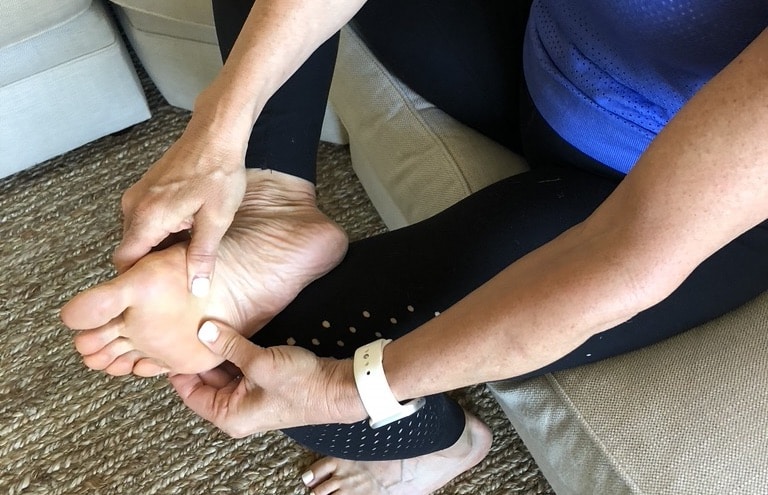
Alphabet Game
Next, sit up in bed and hang your legs over the side to play the alphabet game with your foot. Point your big toe and draw the alphabet from A to Z with each foot to strengthen and stretch the foot and calf.

Roll It Out
After the alphabet game, slowly stand up and place one foot on a massage ball, tennis ball, or frozen water bottle and slowly roll it across the bottom of the foot starting at the heel. Once you reach your toes go back slowly in the other direction.
Repeat 3 times for each foot.
Choosing a frozen water bottle gives you the bonus of reducing inflammation while the rolling massage helps you get prepared to step and move.

Plantar Fasciitis Stretches for Before or After Lunch
Incorporate these stretches for plantar fasciitis either before or after your lunch. They are perfect for the midday break.
Step Stretch
Find the nearest set of stairs and stand on the bottom step. Put the ball of the foot you want to stretch on the step and let the heel drop down for 30 seconds.
Switch to the other foot and do the same. Stretch each foot 3 times.
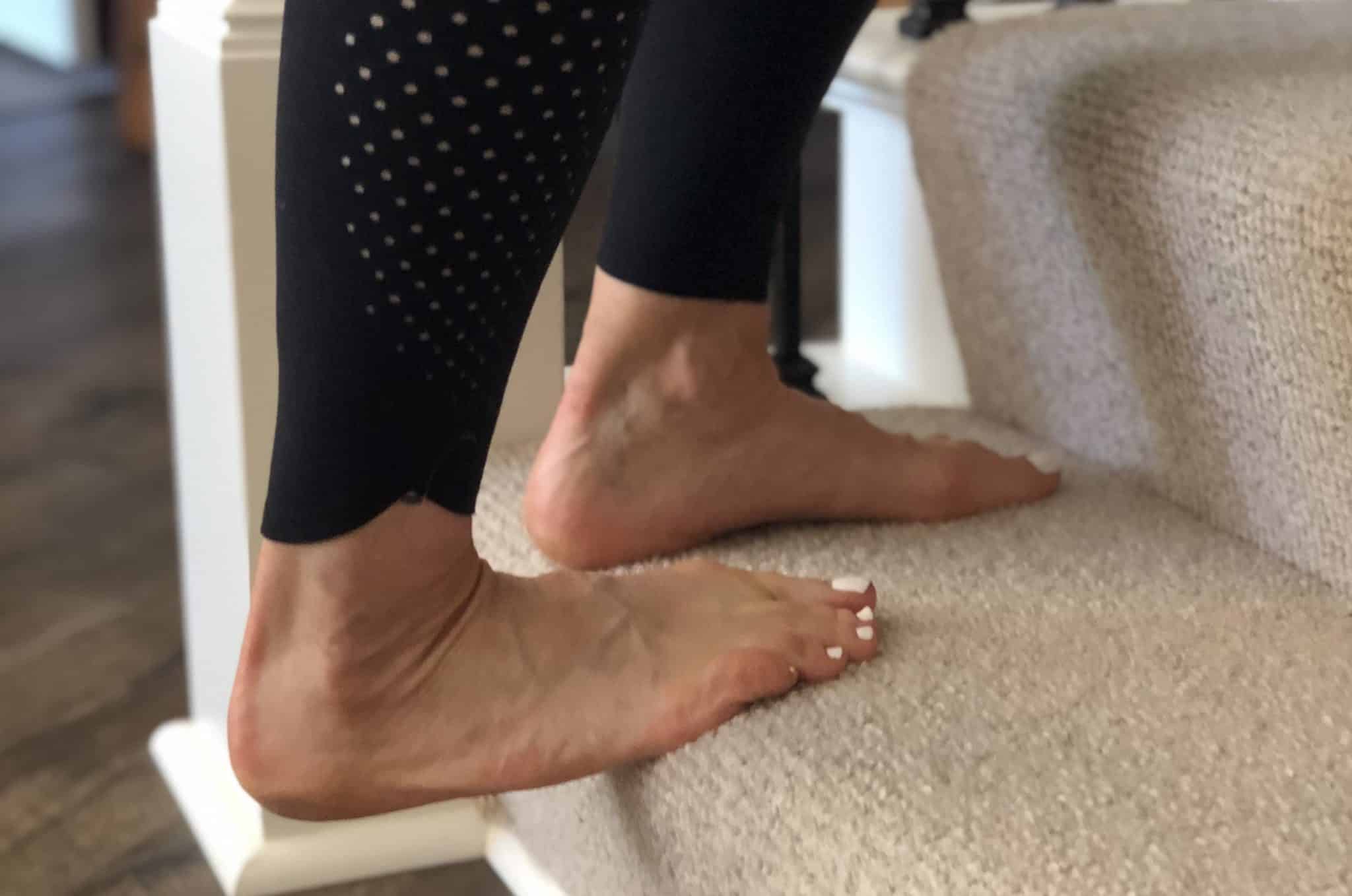
Heel Press
Stand facing a wall and place both hands against the wall. Step one foot back and press the heel of that foot firmly into the ground keeping your leg straight.
Move your hips forward until you feel a stretch in your calf.
Hold 30 seconds. Switch legs and repeat.
Try 3 times per foot. Don’t bounce! Remember that tight calves are often the origin of heel pain.
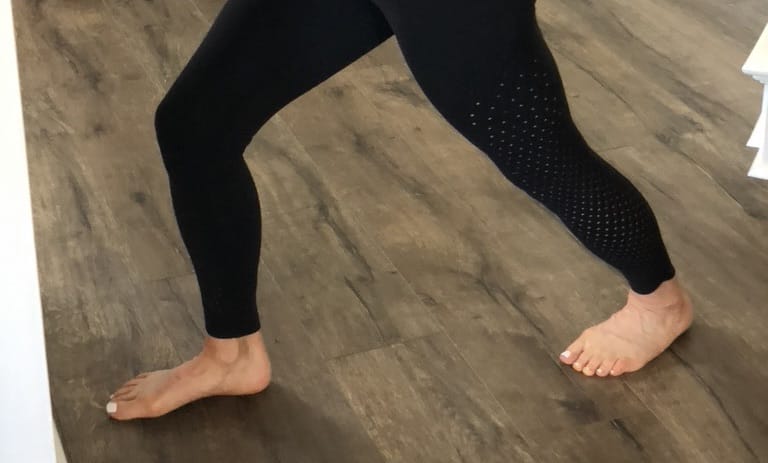
Plantar Fasciitis Stretches for Just Before Bed
Add these plantar fasciitis stretches to your bedtime to routine to finish of you day of exercises!
Washcloth Exercise
Sit on a chair or the edge of your bed with a washcloth on the floor. Keep your heel on the ground and lift the washcloth with your toes.
Release and repeat 10 times. Repeat on the other foot.
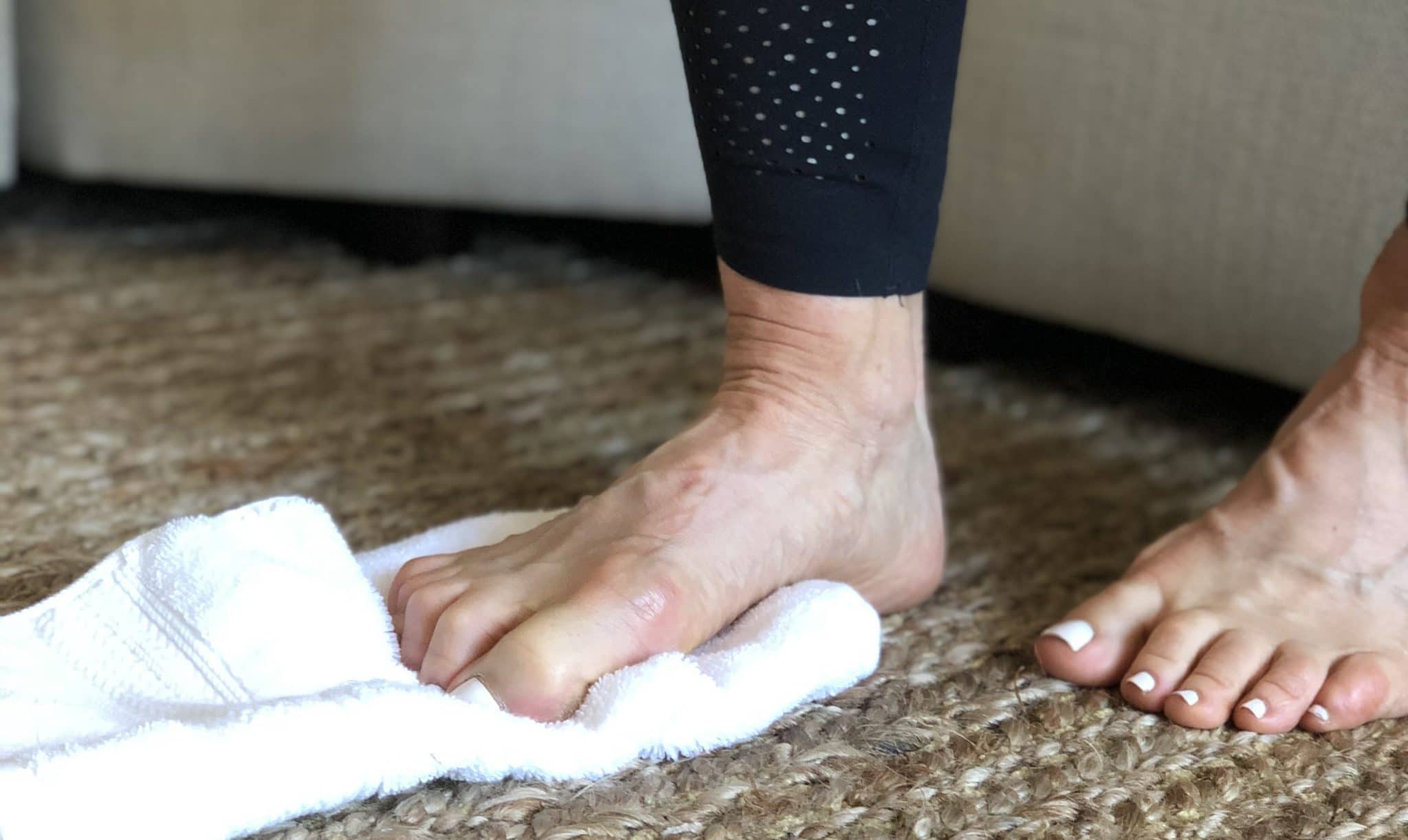
Seated Straight Leg Stretch
Grab a long band and or towel and sit down on the floor with your legs straight out in front of you. Place the band or towel around one foot, keeping that leg straight.
Gently pull back on the band or towel holding for 30 seconds and breathing gently.
Switch to the other floor. Stretch each side 3 times.
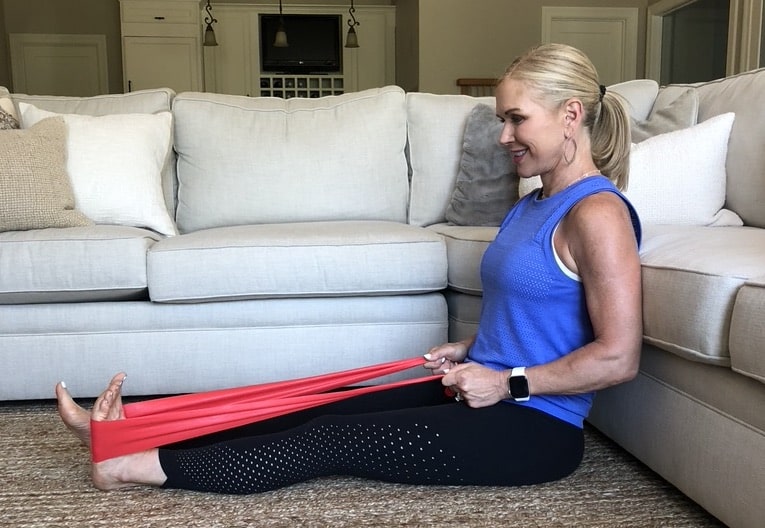
Additional Plantar Fasciitis Treatments
In addition to performing the above stretches for plantar fasciitis, you may want to add on some additional treatments.
When plantar fasciitis is treated early, most people resolve their pain with conservative treatments within six weeks. However, sometimes it takes a few treatments stacked on top of one another.
Here are some tried and true treatment options that can be utilized to relieve plantar fasciitis pain:
Ice
Just like with other injuries, the inflammation of plantar fasciitis can be helped with ice. The best way to do this is to use a frozen water bottle and roll it back and forth under your foot for about 10 minutes, several times a day. Do it at meals, under your desk while you work, or even at night when you watch TV. Be consistent.
Massage
No, you don’t have to pay for it. While you are sitting, roll a tennis ball around under your foot to massage the area. It works like a foam roller for your foot. Of course, the frozen water bottle also serves this purpose.
Medication
Over-the-counter anti-inflammatories can help. Ibuprofen or Naproxin are good bets to reduce inflammation and provide pain relief.
Rest
Your feet need time off from whatever is causing the issue. Stop or cut way back on high-impact exercises.
New Shoes
What a great prescription, huh? Most people wear their workout shoes for far too long before replacing them.
Remember that the plantar fascia muscle, which runs along the bottom of your foot, helps support the arch of your foot. So it makes sense that if you do not wear shoes with proper support you are putting extra wear and tear on that fascia. This leads to the muscle being strained and small tears can be created.
Also, many find relief by wearing supportive shoes or shoe inserts (more on that below) very regularly. Keeping shoes on as much as possible allows the fascia to heal more quickly and maintain support.
Check out my guide for what really matters in a walking shoe to get my expert tips!
Night Splits or Night Boot
Night splints (or a night boot) help relieve plantar fasciitis pain and was the most important thing I did to heal my plantar fasciitis many years ago. A night splint looks similar to a boot or sock.
You put it on your foot before you go to sleep, and the device lifts your toes and holds your foot in a gentle stretch all night long. By holding it in this flexed position, the tendon has a chance to heal.
Shoe Inserts For Plantar Fasciitis
Cheap or improper shoes can be one of the causes of plantar fasciitis, but before you go buying brand new shoes, you may also consider shoe inserts. Inserts last longer and can be moved from shoe to shoe as needed.
Here are some things to keep in mind when looking for shoe inserts:
- Look for insoles that have been well-tested and recommended by other users. If you don’t know someone personally, read the reviews online.
- Take time to know your own feet before you buy. Neutral? Pronator? Supinator? Get a diagnosis from a medical professional or a specialized running store that uses a treadmill to watch you and help you understand your gait.
- Look for inserts with deep heel cups. Generally, those who experience plantar fasciitis need more support in the arches of the feet. A deeper heel cup will provide this. Do you have flat feet? Low Arches? Moderate arches? If you aren’t sure, Runner’s World provides you with the Wet Feet Test that you can do at home to determine the amount of arch support you will need.
- Give the inserts time to break-in. Just like a new pair of shoes, the inserts will change the foot movement and your feet will need time to adjust. Do it in small doses.
Here are a few of our favorite options to help you get started:
- Airplus Plantar Fasciitis Orthotic
- Superfeet Black Premium Insoles
- Powerstep Protech Orthotic Supports
- Powerstep Unisex Pinnacle Maxx Insole
- GEL Orthotic Shoe Gel Insoles
Working Out with Plantar Fasciitis
So, is it okay to work out with plantar fasciitis? Yes!
Exercising with plantar fasciitis is, in general, something you can do. Just be aware that you may have to adjust your workouts until the problem is resolved and even then, make sure you resume your regular activities slowly.
There are two things to remember when you decide to work out with plantar fasciitis.
- It is critically important to wear proper, supportive shoes at all times! Even if you participate in water aerobics, there are shoes for you and you need to have them on!
- Participate only in things that will not contribute to the heel strike or pounding of your feet. Here are some suggestions.
Workouts To Try With Plantar Fasciitis:
These workouts are typically low impact: meaning they reduce the amount of impact that your foot will have to absorb.
- Swimming
- Water Aerobics
- Elliptical Machine
- Weight Lifting
- Cycling with hard surface shoes
- Rowing Machine
- Yoga
- Mat Pilates
Workouts To Avoid With Plantar Fasciitis
These workouts are typically high impact: meaning the amount of impact your foot will have to absorb is not recommended when dealing with plantar fasciitis.
- Running
- Jumping
- Bouncing
- Step Aerobics
- Walking for fitness
- Going barefoot or wearing flip-flops (use shoes even in your home!)
More About Plantar Fasciitis
Plantar fasciitis (“plan-tur-fash-ee-eye-tis”) is a common foot injury and a fairly easy one to fix if you act early.
The plantar fascia is a thick band of connective tissue that runs along the bottom of your foot connecting your heel to the base of your toes. It acts like a shock absorber supporting the arch in your foot.

If tension on the fascia is overloaded, tiny tears are produced resulting in irritation, inflammation and pain. The pain might feel like a stabbing sensation in the heel or arch of the foot, or it might feel more like deep aching or throbbing.
Most people feel this pain when getting out of bed in the morning. The pain generally subsides as the foot gets warmed up and moving.
This is because the fascia is contracted at night almost as if it tries to heal itself. When you step on it getting out of bed, a sudden strain occurs all over again.
If you have plantar fasciitis, you may be looking for exercises and stretches for relief and to help heal. And the sooner you start to treat plantar fasciitis the better since the longer you wait, the worse it typically gets and the longer it will take to heal.



Thanks for covering this topic Chris. Definitely one of the best and most helpful articles on plantar fasciitis that I’ve read. I’m in my early 40’s and exercise several times a week, but was sidelined on and off for several months last year with PF. First in both feet, then in just my left foot. Wish I had your article to read then. I finally found relief with lots of stretching, foot massage to “break up” the tissue, and extended periods of rest. I also switched to a zero drop shoe. So far no recurrence of PF. Now if I do notice any tenderness in either of my heels, I take extra care to address it right away. It’s crucial to prevention. Thanks again and I LOVE everything you’re doing here on GetHealthyU!!!!
http://www.activerelease.com/
I had PF for over 10 years did everything in the article u said only thing that fixed me for good was ART see link i now only work on prevention but pain free and have my life back.
This was some great information. if I didn’t cure my Plantar Fasciitis a few months ago this would have been my one and only stop. Its great to see someone else helping out people with pf. I also have blog on PF as well, because I spent hundreds of dollars trying to cure mine. I wanted to save people the money I ad to spend on finding a cure for myself. please feel free to check out my blog, as I have very useful information there as well
Forgive my ignorance but what is a zero drop shoe mentioned in Amy B comment.
In Shannon she mentions the only fix for her for good was ART and see link. What is ART, couldn’t find the link.
I have PF for the second time in my life. More painful & has lasted longer than the first time. Have
tried the exercises, have a night boot, & have now had to suspend my workouts. I really think mine started when I did a barre class (no shoes) with a lot of pointed toes! I have stopped going
to the gym now as every exercise I do seems to aggravate it. I use ice packs, but does anyone know whether or not to use heat? I try to rest it a lot but is difficult, as I am usually a very active person. I’m also wondering about a zero drop shoe and ART??
i recently got PF from barre too!! I could feel it happen during one of the interval classes. It has been hurting for 7 weeks now and I need to go see a foot doctor. My normal doctor only said to stretch and take ibprofen then charged me 30$ ughhhh
I started practicing Barre, I am even on a track to become certified to teach! However, I started feeling pain in my foot around the top of my heel and didn’t realize it was PF until recently. I researched all over the internet and all the suggestions above really do help. I am still in recovery, but it is much easier for me to walk in the morning while gettingo ut of bed. My biggest thing is wearing supportive shoes ALL. THE. Time! I use running shoes with orthotics, even at work. I would hate to give up Barre. I try doing the exercises in my running shoes but I am wondering if the special shoes made for Barre might be enough. I don’t tink barefoot is an option for me any longer. I have over pronounced arches from practicing Ballet many years in my childhood and I also have flat feet. So orthotics are a must. Keep up with the massaging, supportive footwear, stretches, etc, and you will be on your way to relief.
The only relief I’ve gotten for my PF are a pair of ugly shoes.
The Croc Rx, only available from their site online, is the only shoe I’ve been able to wear and be 99% pain free.
It’s around $50 and is rubber and comes in blue, black and tan. Your feet get wet on wet days, and sweat on hot days. Horrible looking shoes! But…I can walk pain free!
I used to have a very severe form of plantar fasciitis… But, now I remember it only as a bad dream!
I’m a busy person, so I had no time to see doctors, get acupuncture or physiotherapy. I didn’t know what to do and the pain was killing me, I could barely walk. So, I did a research hoping to find something that could help me. And guess what?
I found one e-book which taught me a lot about plantar fasciitis, it’s symptoms, causes and how to cure it. I followed it carefully and I completely got rid of my plantar fasciitis in 3 days! Can you believe that? I thought it’s a miracle, but then I did some more research about this e-book and found a lot of satisfied people who also claimed that they cured they plantar fasciitis fast. What a finding!
I’m leaving a link below which leads to a review of this e-book:
dietandhealthreviews*com/fast-plantar-fasciitis-cure-review/
(just replace * with a dot, because I can’t post links here)
Have a good day 🙂
I have had chronic pf for 10 years. 10 years of being restricted to everything I love doing. Always VERY active but now feel crippled. It’s basically ruined life with my husband. Pretty much house bound. I have been to many doctors who pretty much say there is no hope UNLESS you cut the tendon. Hence another kind of handicap. Stretching helps for awhile but then eventually returns. Hopeless!
So sorry to hear that Mary Ellen. I hope you’ll try some of these remedies and that you might find some relief. From my personal experience, sleeping with the boot at night helped most. Good luck!
I notice no one addressed the “Zero Drop shoes” for Dianne, but I’m guessing by now she found out that is a brand name sneaker, which I’m guessing offers great support for people with PF who want to continue exercising. I’ll be looking into those myself!
I tried zero drop shoes, but for me they didn’t really seem to help the PF. And wearing them just eventually caused a really painful tendinitis along the inner part of my foot and ankle. However, I am quite flat footed and a severe over pronator…basically my feet are a hot mess. The zero drop shoe (Altra’s) didn’t give me enough support for the overpronation.
Birkenstocks have helped me tremendously with my PF. I would recommend them.
I had problems with my feet too and it was heel pain. Later I found out that I had plantar fasciitis. However, I got rid of it quite easily. If you don’t mind I’d like to share my experience of how I dealt with plantar fasciitis.
I’m a busy person, so I had no time to constantly see doctors, get acupuncture or physiotherapy. I didn’t know what to do and the pain was killing me, I could barely walk back then. So, I did a research hoping to find something that could help me. And guess what?
I found one e-book which taught me a lot about plantar fasciitis, it’s symptoms, causes and how to cure it. I followed it carefully, did specific exercises and stretches and I completely got rid of my plantar fasciitis in 10 days! Can you believe that? I thought it’s a miracle, but then I did some more research about this e-book and found a lot of satisfied people who also claimed that they cured they plantar fasciitis fast. What a finding!
I’m pasting a link below which leads to a review of this e-book:
http://dietandhealthreviews.com/fast-plantar-fasciitis-cure-review/
I hope this will help someone who has heel painor even plantar fasciitis 🙂
Is this free? I keep going to one that is not free.
No, it’s not free, she’s trying to scam you FIY. You don’t need that book, all the info you need you can find online, for free!